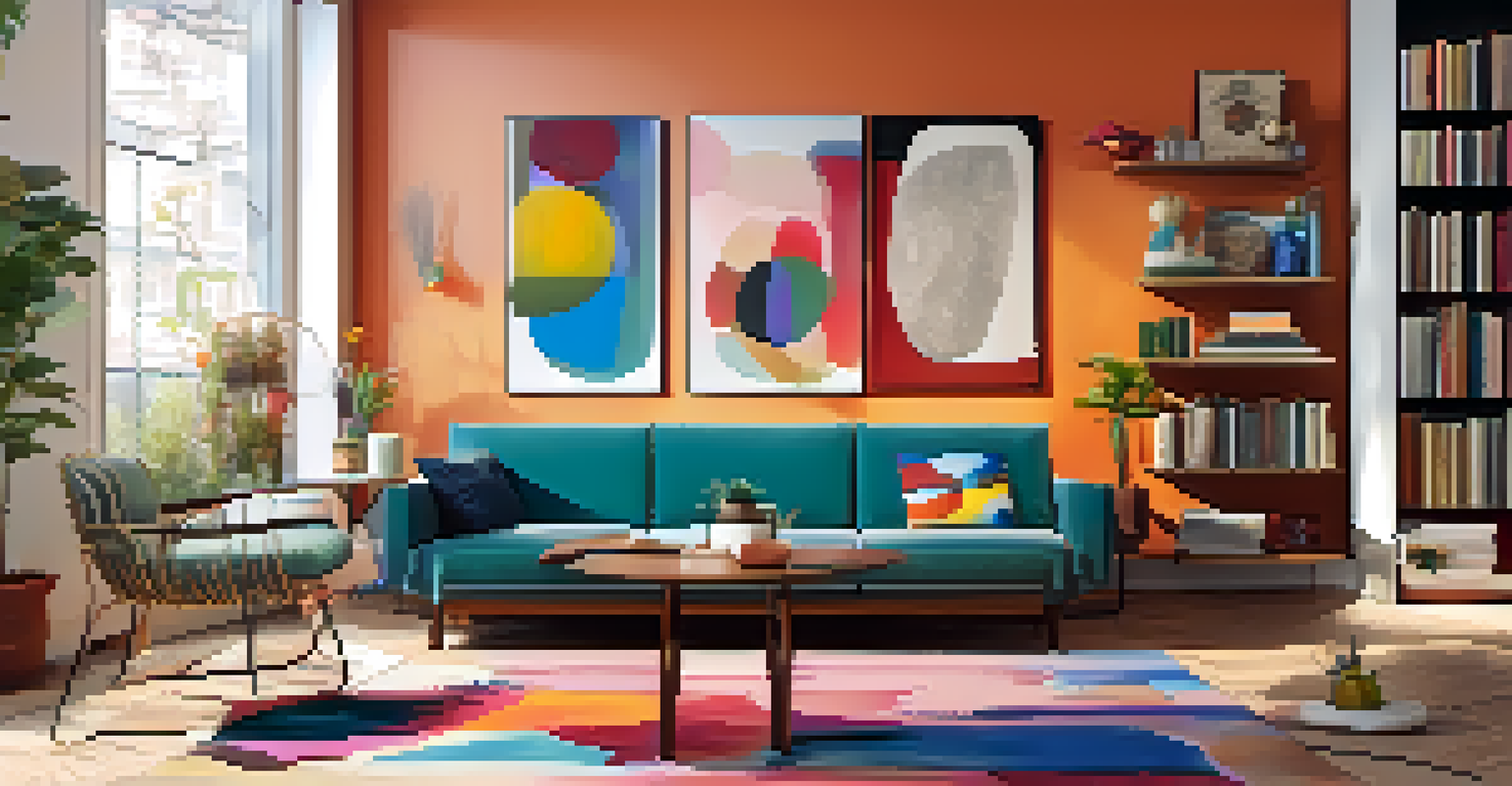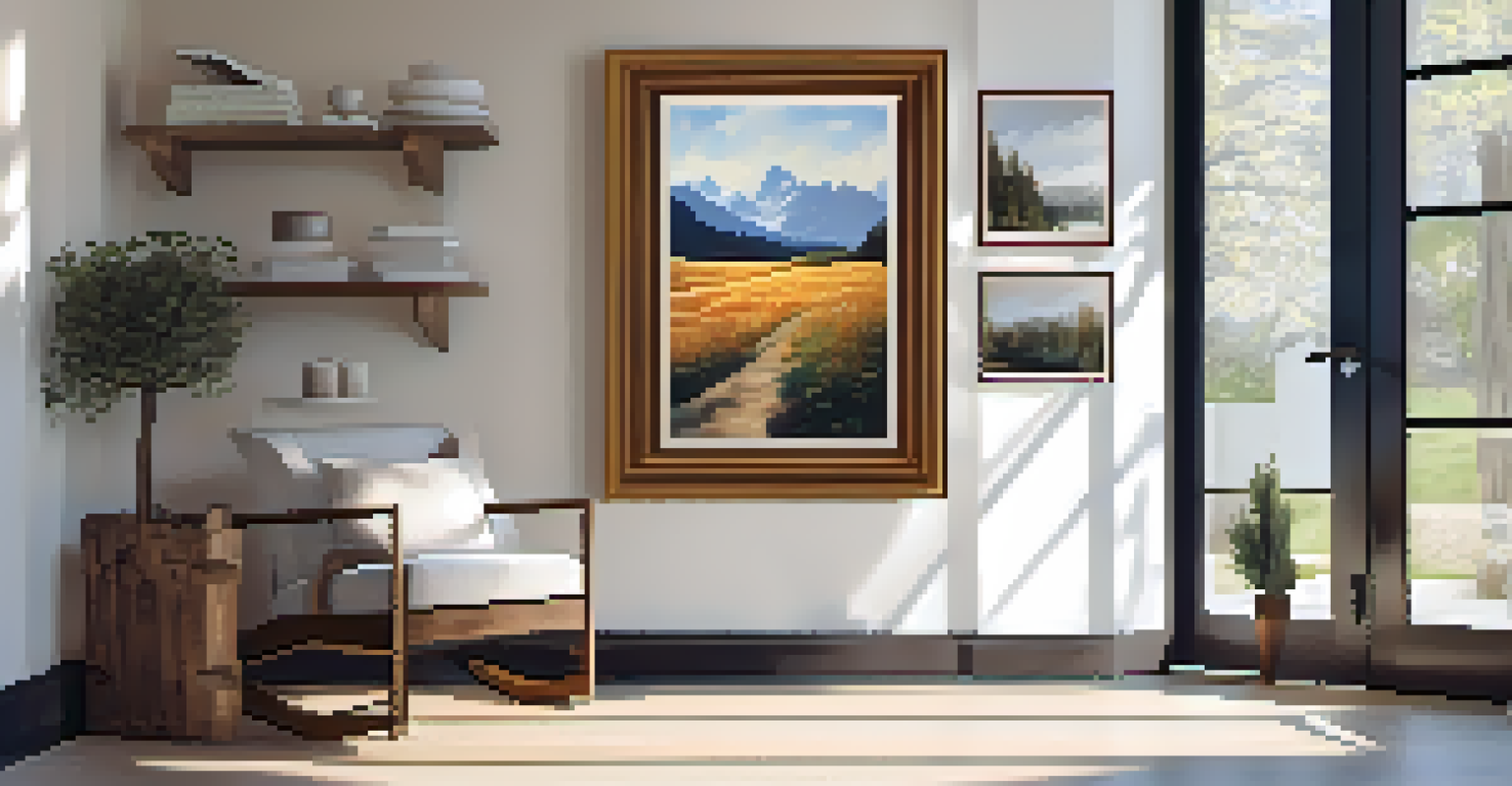Artful Arrangements: Displaying Art in Small Homes

Understanding the Importance of Art in Small Spaces
Art transforms a house into a home, especially in small spaces where every piece counts. It adds personality and warmth, making even the coziest corner feel inviting. Plus, the right artwork can reflect your style and tell your story, creating a unique ambiance.
Art enables us to find ourselves and lose ourselves at the same time.
In a small home, art can serve as a focal point or a subtle complement to the decor. It helps draw the eye, creating a sense of interest and depth, which is often crucial in compact areas. By choosing pieces that resonate with you, you can turn limited space into a gallery of your life.
Ultimately, the key is to embrace the challenge of limited space and use art to enhance it. Rather than seeing small areas as a limitation, consider them opportunities to curate a thoughtful and engaging display. This mindset shift can lead to creative solutions that make the most of what you have.
Choosing the Right Art for Small Spaces
When selecting art for your home, consider scale and proportion. Large pieces can overwhelm a small room, while tiny art can get lost on expansive walls. Aim for a balance that enhances your space without overcrowding it, ensuring each piece gets the attention it deserves.

Think about the style and colors that resonate with your overall decor. For instance, if you have a minimalist aesthetic, a few striking pieces may be more impactful than a gallery wall filled with smaller artworks. This approach can create a serene environment while still showcasing your personality.
Art Adds Personality to Small Spaces
Incorporating art into small areas enhances warmth and reflects your unique style, creating a cozy and inviting atmosphere.
Don’t shy away from varying textures and mediums, either. Incorporating different styles—like photography, paintings, or sculptures—can add depth and interest to your display. This variety invites exploration and can make your small space feel more dynamic and layered.
Creative Ways to Display Art in Limited Space
When it comes to displaying art, think beyond traditional frames. Consider using clips, washi tape, or even hanging art from a wire to create an informal gallery. This method allows for easy changes and rearrangements, keeping your space fresh and exciting.
The best artist has no conception that a marble block does not contain within it, but only the artist's vision can release it.
Vertical spaces are often overlooked in small homes, but they can be an excellent canvas for your art. Wall-mounted shelves can hold smaller pieces or books, while tall, narrow artworks can draw the eye upward, creating the illusion of height. This technique not only showcases your collection but also maximizes your available space.
Additionally, integrating art with functional decor can be a clever way to save space. For example, a decorative ladder can display framed photos or art prints, while also providing storage for blankets or books. This dual-purpose approach can keep your home organized while still celebrating your artistic side.
Utilizing Multi-Functional Furniture for Art Display
Multi-functional furniture can be a game-changer in small homes, providing both utility and art display opportunities. A coffee table with a shelf can hold art books or small sculptures, while an ottoman might double as storage for your art supplies. This way, you not only save space but also create a curated look.
Consider furniture pieces that are visually interesting themselves, such as a vintage trunk or a uniquely shaped side table. These items can serve as platforms for displaying smaller artworks or even a plant that complements your art collection. The key is to choose pieces that add character to your space.
Balance Scale and Style in Art
Choosing the right size and style of artwork ensures it complements your space without overwhelming it, striking the perfect balance.
Additionally, think about how to arrange your furniture to create mini galleries. For instance, a corner nook can be transformed into an art display area with a small side table and a few artworks leaning against the wall. This setup invites conversation and admiration while keeping your space feeling cozy.
Creating a Gallery Wall Without Overwhelming Space
Gallery walls are a popular way to showcase multiple pieces, but they can be tricky in small homes. To avoid overwhelming your space, select a cohesive color palette or theme that ties the pieces together. This strategy helps create a sense of unity despite the variety of artworks.
Start by laying out your arrangement on the floor before hanging anything. This allows you to visualize the spacing and ensure the design feels balanced. Remember, the goal is to create a harmonious display that invites the eye to wander without feeling chaotic.
Another tip is to vary the frame styles and sizes, which can add interest while keeping the overall look cohesive. Grouping smaller pieces with larger ones can create visual excitement and prevent the display from feeling one-dimensional. Embrace the creative process and have fun curating your unique gallery wall.
Incorporating Natural Elements to Enhance Art Displays
Bringing in natural elements, like plants or wooden accents, can beautifully complement your artwork. A vibrant potted plant next to a framed painting can create a lively contrast, enhancing both the art and the ambiance. This mix of art and nature adds warmth and depth to your space.
Consider using nature-inspired art as well. Artwork featuring landscapes, botanical prints, or abstract pieces inspired by nature can create a cohesive look when paired with real plants. This connection brings a sense of balance and tranquility to your home.
Refresh Art Displays Regularly
Regularly updating your art collection keeps your home feeling lively and allows you to showcase different pieces based on your mood and the seasons.
Additionally, natural light plays a vital role in art display. Position your art where it can be illuminated by daylight, as this can enhance colors and textures. However, be mindful of direct sunlight, which can fade certain artworks over time. Finding the right spot is crucial for both your art and your overall atmosphere.
Maintaining and Refreshing Your Art Display Over Time
Art should evolve with you, so don’t hesitate to refresh your displays periodically. Changing up your artwork can bring new life to your space and reflect your current tastes and experiences. It’s a great way to keep your home feeling lively and engaged.
Consider rotating artwork based on seasons or your mood. For example, bright, cheerful pieces can be perfect for spring, while cozy, warmer tones might suit the fall. This practice not only keeps your decor fresh but also allows you to enjoy pieces that might not be on display all the time.

Lastly, maintain your art by cleaning frames and checking for any signs of wear or damage. Regular care ensures that your collection remains vibrant and visually appealing. A little upkeep goes a long way in preserving the beauty of your art while keeping it an integral part of your home.